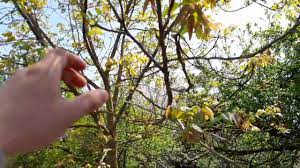
Every walnut tree has both male and female flower parts. Pollen is transferred by wind from male to female flower parts. All walnut varieties are self-fertile, meaning that the pollen can travel from the male parts to the female parts of the same tree and under this procedure the tree can produce nuts. Thus, a single tree can theoretically produce nuts without needing other walnut trees around. However, in most cases, pollen that is transferred through the wind to the female parts of the same tree (stigma) is often lost, because at that time the female flower is not receptive. Consequently, the best way to ensure adequate pollination in order to achieve the highest possible fruit set and yield is to ensure cross pollination by planting two or more varieties. Planting a walnut variety that produces pollen early, along with another variety that produces pollen later will ensure that adequate pollen will travel throughout the wind to female flowers of both varieties during the period of their receptivity. Most walnut farmers plant 1 row of pollinator variety to every 8-12 or more rows of the main variety. They plant the row with the pollinator trees perpendicularly to the wind direction in order to maximize wind pollen dispersal. Moreover, having all the pollinator trees planted in the same row will make harvesting and sorting of different nuts much easier. However, some walnut farmers plant randomly the trees of the pollinating varieties in the walnut orchard.
https://wikifarmer.com/
